Apple Inc.’s journey through the annals of technology is a saga of audacious innovation, market disruption, and cultural transformation. Delving into the History of Apple Inc.: A Timeline of Innovation and Market Disruption, we’ll embark on an immersive exploration of the pivotal moments that shaped the company’s rise to global prominence. From the introduction of the revolutionary Macintosh to the advent of the iPhone and the subsequent mobile revolution, Apple’s legacy is one of constant reinvention and industry leadership. Join us as we trace this remarkable odyssey of technological advancements and cultural impact.
Key Takeaways:
Apple Inc., co-founded by Steve Jobs, Steve Wozniak, and Ronald Wayne in 1976, embarked on a transformative journey in the tech industry.
Their brainchild, the Apple I computer, marked the beginning in 1976, followed by the successful initial public offering (IPO) in 1980, valuing the company at nearly $2 billion.
The Macintosh in 1984 stood out as a revolutionary personal computer with the introduction of a graphical user interface.
In 1985, Steve Jobs’ departure from Apple due to internal conflicts marked a challenging transition.
Steve Jobs’ triumphant return in 1997 initiated a period of remarkable restructuring and revitalization for the company.
The iMac, an innovative all-in-one computer, made its debut in 1998, propelling Apple’s resurgence.
Apple’s success soared with the launch of the iPod in 2001, cementing its position as a leader in portable MP3 players.
The iPhone, unveiled in 2007, revolutionized mobile communications and reshaped the industry landscape.
Apple’s expansion continued in 2010 with the introduction of the iPad, a widely acclaimed tablet computer.
The passing of Steve Jobs in 2011 marked a significant loss for Apple and the tech world.
Apple achieved the milestone of becoming the first U.S. company to reach a market capitalization of $1 trillion in 2015.
The cutting-edge iPhone X, featuring a bezel-less display and facial recognition technology, was introduced in 2017, pushing the boundaries of smartphone innovation.
The company experienced remarkable growth in the 1980s, with profits exceeding $100 million and its workforce expanding to over 1,000 employees by 1980.
History of Apple Inc. Timeline:
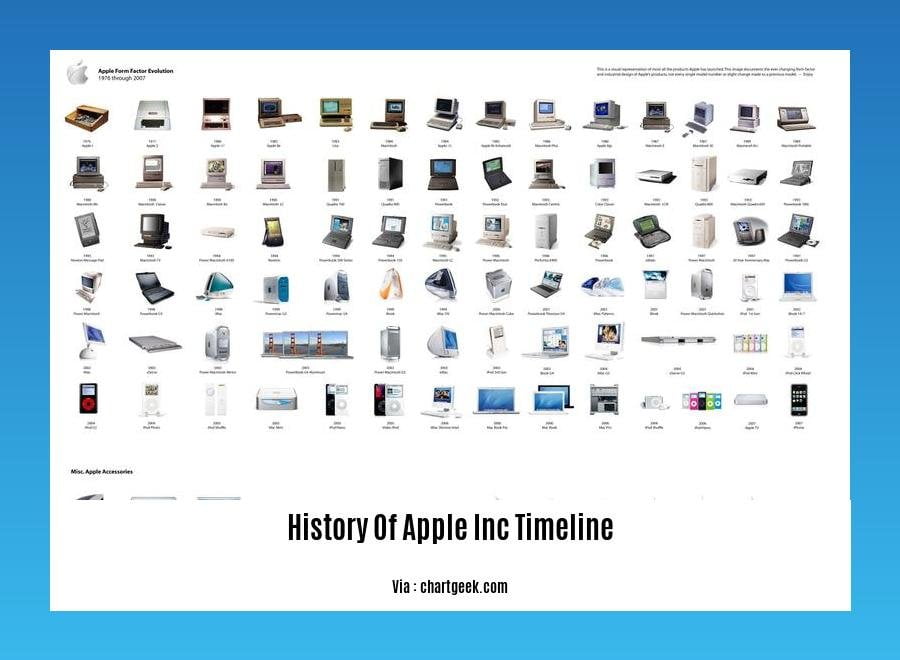
Apple Inc., a global technology powerhouse, has woven a remarkable tapestry of innovation and market disruption throughout its rich history. From its humble beginnings in 1976 to its current status as a trillion-dollar enterprise, the journey of Apple is a tale of vision, perseverance, and a relentless pursuit of excellence.
Key Milestones that Shaped an Empire:
1976: The Genesis of Apple: In a garage in Los Altos, California, the story of Apple Inc. begins with Steve Jobs, Steve Wozniak, and Ronald Wayne.
1977: The Apple II Revolution: Apple II, a personal computer that revolutionized the industry, is introduced to the world, setting the stage for Apple’s future dominance.
1980: Public Listing and Exponential Growth: Apple goes public, marking a pivotal moment in its history. With an initial valuation of nearly $2 billion, the company’s potential becomes undeniably clear.
1984: The Macintosh Era: The Macintosh, a graphical user interface-based personal computer, marks a quantum leap in technology. This innovation sets Apple apart and establishes its reputation as a pioneer.
1997: Steve Jobs’ Triumphant Return: After a brief hiatus, Steve Jobs returns to Apple, bringing with him his charisma and vision. Under his leadership, the company embarks on a remarkable turnaround.
1998: The iMac’s Vibrant Revival: The iMac, an all-in-one computer with its translucent casing and vibrant colors, revitalizes Apple’s fortunes and becomes an iconic symbol of the company’s resurgence.
2001: The iPod’s Musical Revolution: Apple unveils the iPod, a portable MP3 player that revolutionizes the way people listen to music. Its sleek design and user-friendly interface make it a runaway success.
2007: The iPhone’s Unparalleled Impact: The iPhone, a revolutionary smartphone that merges computing, communication, and entertainment, is released. It reshapes the mobile landscape forever, establishing Apple as an industry leader.
2010: The iPad’s Tablet Dominance: Apple expands its product line with the iPad, a tablet computer that combines portability and functionality. It quickly becomes a must-have device, further solidifying Apple’s position as an innovation powerhouse.
2011: Steve Jobs’ Legacy: The passing of Steve Jobs, Apple’s visionary co-founder, leaves a void in the tech world. His legacy lives on through the company’s continued pursuit of game-changing products.
2015: Trillion-Dollar Milestone Achieved: Apple becomes the first U.S. company to reach a market capitalization of $1 trillion, a testament to its enduring success and global influence.
Enduring Impact on the Tech Landscape:
Apple’s journey is marked by continuous innovation and market disruption. Through iconic products like the Macintosh, iPod, iPhone, and iPad, the company has transformed industries, set new standards, and shaped the way we interact with technology.
Throughout its history, Apple has faced challenges, setbacks, and controversies. Yet, the Apple Inc. timeline remains a testament to the company’s resilience, adaptability, and unwavering commitment to pushing the boundaries of what’s possible.
-Curious about the journey of Apple computers through the years? Discover the evolution of the tech giant’s creations in this comprehensive history of Apple computers timeline.
-Unlock the captivating timeline of art movements and iconic works through this visually stunning history of art timeline poster.
-Explore the rhythmic evolution of bachata’s captivating dance and music through this detailed history of bachata.
1984: Apple launches the Macintosh, introducing a revolutionary graphical user interface (GUI) that transforms the way people interact with computers.
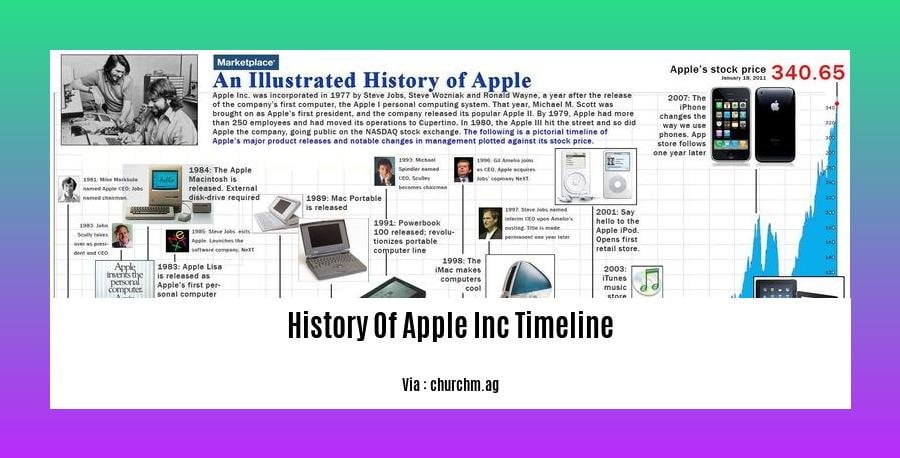
The year 1984 marked a pivotal moment in the annals of technology, with Apple launching the Macintosh, a revolutionary personal computer that transformed the way people interacted with computers. This groundbreaking innovation heralded the advent of the graphical user interface (GUI), a radical departure from the command-line interfaces that had dominated the computing landscape until then.
The Macintosh’s GUI, controlled by a mouse or graphics tablet, allowed users to interact with the computer in a more intuitive and user-friendly manner. Icons, menus, and windows replaced the complex commands and cryptic text prompts, making computing accessible and empowering to a broader audience.
Apple’s iconic “1984” Super Bowl commercial, a masterpiece of advertising that mirrored George Orwell’s dystopian novel, captured the essence of the Macintosh’s revolutionary spirit. It portrayed the computer as a tool of liberation, a weapon against the conformity and oppression symbolized by Big Brother.
Key Takeaways:
- Revolutionary Interface: The Macintosh introduced a user-friendly graphical user interface (GUI), revolutionizing the way people interacted with computers.
- Intuitive Controls: A mouse or graphics tablet replaced the complex command-line interfaces, making computing accessible to a wider audience.
- Cultural Impact: The “1984” Super Bowl commercial cemented the Macintosh’s status as a symbol of freedom and innovation, capturing the public’s imagination.
- Legacy: The Macintosh’s GUI became the industry standard, influencing the design and functionality of modern computers and laptops.
The Macintosh’s legacy extends far beyond its initial release in 1984. It paved the way for modern operating systems and laid the foundation for the intuitive and user-friendly interfaces we take for granted today. The Macintosh’s impact on the tech industry cannot be overstated, and it remains an iconic symbol of innovation and disruption.
Sources:
- AppleInsider
- Computer History Museum
2001: The introduction of the iPod, a portable media player that revolutionizes the music industry and establishes Apple as a leader in consumer electronics.
The digital music scene saw a groundbreaking transformation in 2001 when the iPod, an ingenious masterpiece of engineering and design, made its grand entrance into the world. This sleek, handheld marvel revolutionized the way we consume music.
Combining style and functionality, the iPod boasted an impressive 1,000-song capacity, putting a colossal music collection at your fingertips. Navigating your favorite jams was a breeze with the iconic scroll wheel, a testament to Apple’s innovative prowess.
The iPod’s impact on the music industry was nothing short of seismic. It liberated music lovers from the constraints of CDs and cassettes, allowing them to create custom playlists, store countless songs, and enjoy their tunes on the go.
Apple didn’t stop there. They established the iTunes Music Store, an online music emporium that allowed users to purchase individual songs, marking a shift from the traditional album-buying model. This move solidified Apple’s position as a key player in the digital music distribution landscape.
The iPod’s success spawned a family of devices, each tailored to specific needs. The iPod mini brought portability to new heights, the iPod nano boasted an ultra-slim profile, and the iPod shuffle added a touch of spontaneity with its ability to play songs in random order.
The iPod’s reign ended in 2022 when Apple discontinued its production. Smartphones had effectively merged the functionality of an iPod with a phone, making the dedicated MP3 player obsolete.
But the legacy of the iPod lives on. It paved the way for the digital music revolution, popularized the concept of portable music players, and established Apple as a trailblazer in consumer electronics. Its sleek design and user-friendly interface continue to inspire modern-day devices.
Key Takeaways:
The iPod, unveiled in 2001, revolutionized the music industry by offering a portable MP3 player with an impressive storage capacity.
Apple’s iTunes Music Store, launched alongside the iPod, changed the music distribution landscape by offering individual song purchases.
The iPod spawned a series of successful models, including the iPod mini, iPod nano, and iPod shuffle, each catering to different user preferences.
Despite being discontinued in 2022 due to the rise of smartphones, the iPod left an indelible mark on the digital music era.
Sources:
2007: The release of the iPhone, a groundbreaking smartphone that merges computing, communication, and digital media, forever changing the mobile landscape.
In 2007, the tech world witnessed a watershed moment when Apple Inc. unveiled the iPhone, a revolutionary device that redefined the mobile phone industry. This innovative smartphone converged computing, communication, and digital media into a sleek, user-friendly package, permanently altering the way we interact with technology.
The iPhone’s impact was immediate and profound. With its finger-friendly touchscreen interface, wireless internet connectivity, and a plethora of groundbreaking features, the iPhone redefined the mobile experience. It paved the way for the smartphone era, setting a new standard for mobile innovation and user-centric design.
The iPhone’s success can be attributed to several key factors:
Intuitive User Interface: The iPhone’s touchscreen interface revolutionized the way people interacted with their phones. Its intuitive gestures and on-screen keyboard made it easy for users to navigate and interact with the device.
App Store Ecosystem: The iPhone’s App Store, launched in 2008, transformed the mobile app landscape. It provided a centralized platform for developers to distribute their apps, creating a vibrant ecosystem that fostered innovation and fueled the growth of the mobile app industry.
Elegant Design: The iPhone’s sleek and minimalist design set a new aesthetic standard for mobile devices. Its slim profile and clean lines made it a fashion statement as much as a technological marvel.
The iPhone’s impact extended beyond the realm of technology. It revolutionized the way people communicate, consume media, and conduct business. It transformed the mobile phone from a mere communication tool into an indispensable personal assistant, entertainment hub, and productivity powerhouse.
Key Takeaways:
The iPhone’s launch in 2007 marked a pivotal moment in the history of mobile technology.
Its innovative touchscreen interface, wireless internet connectivity, and user-friendly design revolutionized the mobile experience.
The iPhone’s App Store ecosystem fostered a thriving community of developers and fueled the growth of the mobile app industry.
The iPhone’s sleek design and intuitive interface set a new standard for mobile devices, making it a fashion statement and a technological marvel.
The iPhone’s impact extended beyond technology, transforming the way people communicate, consume media, and conduct business.
Sources:
Apple Newsroom: iPhone
Wired: The iPhone Turns 15
FAQ
Q1: What was the key product that launched Apple Inc?
A1: The company’s journey began in 1976 with the release of the Apple I, a revolutionary personal computer that marked the inception of the company’s legacy in the tech industry.
Q2: How did Apple’s valuation transform in its early years?
A2: Apple’s valuation experienced a remarkable surge within a few years of its inception. By 1980, the company’s market capitalization reached nearly $2 billion, showcasing its rapid growth and the potential of its innovative products.
Q3: What made the Macintosh a revolutionary product in the computing industry?
A3: The Macintosh, released in 1984, revolutionized the personal computer landscape with its groundbreaking graphical user interface (GUI). This intuitive and user-friendly interface, controlled by a mouse or graphics tablet, made computing more accessible and marked a significant shift from the command-line interfaces prevalent at the time.
Q4: How did the iPod transform the music industry?
A4: The iPod, introduced in 2001, revolutionized the way people experienced music. Its sleek design, coupled with its user-friendly interface and iTunes music store, made it a revolutionary device for portable digital music. The iPod’s popularity skyrocketed, and it became a cultural phenomenon, changing how individuals consumed and enjoyed music.
Q5: What was the significance of the iPhone’s introduction in 2007?
A5: The iPhone, unveiled in 2007, marked a pivotal moment in the mobile communications industry. It combined the functionality of a mobile phone, an iPod, and an internet device into a single, sleek device. The iPhone popularized touchscreen technology and paved the way for the smartphone era, revolutionizing the way people communicated, accessed information, and consumed media.
- China II Review: Delicious Food & Speedy Service - April 17, 2025
- Understand Virginia’s Flag: History & Debate - April 17, 2025
- Explore Long Island’s Map: Unique Regions & Insights - April 17, 2025
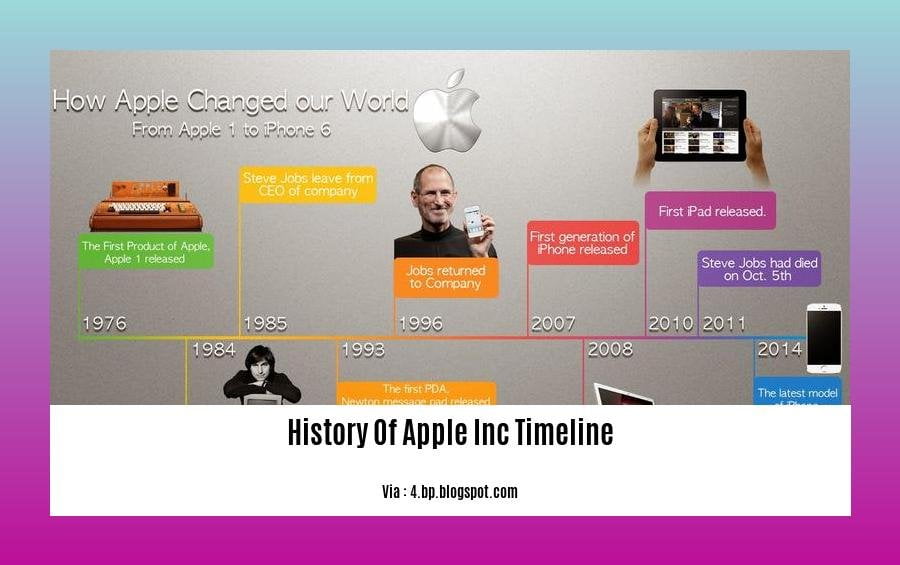
![Unveiling Apple's Legacy: A Comprehensive Timeline of Innovation [apple company history timeline] apple-company-history-timeline_2](https://www.lolaapp.com/wp-content/uploads/2023/12/apple-company-history-timeline_2-150x150.jpg)
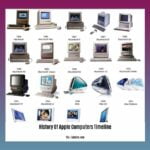

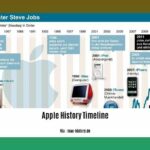
![The Evolution of the Apple Store: A Comprehensive Timeline of Retail Innovation [Apple Store History Timeline] apple-store-history-timeline_2](https://www.lolaapp.com/wp-content/uploads/2023/12/apple-store-history-timeline_2-150x150.jpg)










